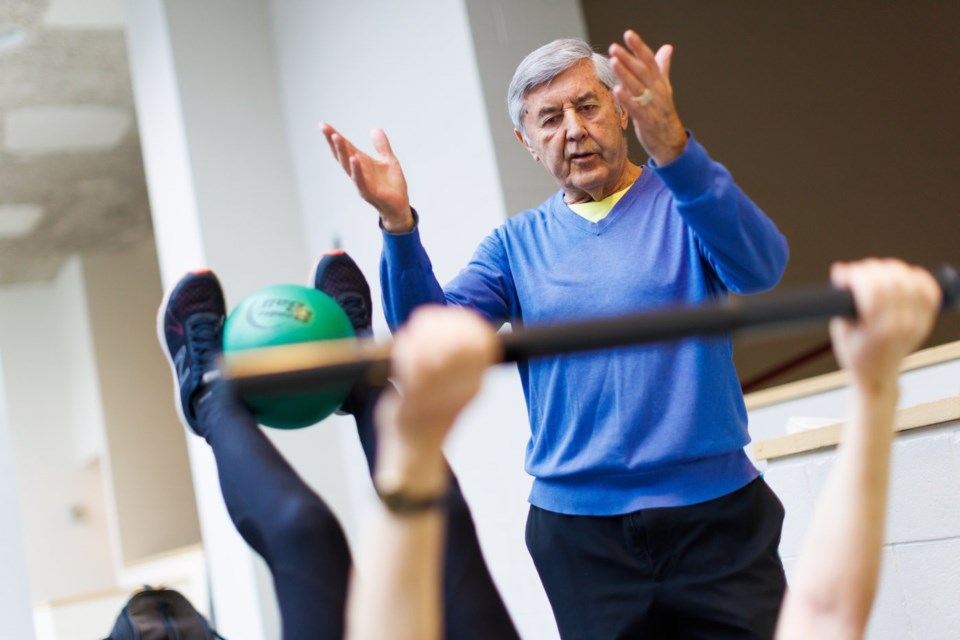TORONTO — Bob Bursach has worked with professional athletes over the course of his career as a personal trainer — but these days, he's focused on helping seniors make exercise part of their lives.
"The first thing that they notice is that (their) strength is coming back," said Bursach, who is 82 and lives in Toronto.
His oldest client is a 96-year-old woman he trains twice a week.
Bursach attributes his good health and youthful appearance to his near-daily workouts. He enjoys seeing his clients improving their quality of life through exercise — such as when they realize they can get up from lying down without taking his hand or using a chair for assistance.
Regular physical activity is critical to improving health at any age, including people in their 80s and 90s — and doctors should be prescribing it more often to their oldest patients, a new paper published Monday in the Canadian Medical Association Journal says.
Physicians sometimes worry more about the risk of injury than the benefits of exercise for seniors with chronic conditions, who are considered frail or who might be at risk of falling, said lead author Dr. Jane Thornton, Canada Research Chair in Injury Prevention and Physical Activity for Health at Western University.
"Age or frailty or functional impairments — we used to see them as contraindications so that we do not prescribe physical activity," Thornton, who is also the medical and scientific director at the International Olympic Committee, said in a phone interview from Lausanne, Switzerland.
"But now the tides are turning and we're really thinking, 'No, hang on a second. We really need to consider these benefits (to exercise).' So those are not contraindications, but rather reasons to prescribe physical activity," she said.
Thornton and her research team reviewed the most up-to-date studies on exercise and aging so they could put together clear advice for doctors.
"Physical activity is a modifiable risk factor for more than 30 chronic conditions relevant to the older adult (including coronary artery disease, heart failure, Type 2 diabetes mellitus, chronic obstructive pulmonary disease, osteoporosis, depression, dementia, and cancer)," their review said.
The review included one 2023 meta-analysis of several studies that looked at the impact of exercise on adults and found the World Health Organization's recommendation of at least 150 minutes per week of moderate physical activity reduced the risk of death by 31 per cent compared to doing no exercise.
Thornton said "it's never too late" to begin exercising.
"We can start at any time and really make a marked improvement in our daily life," she said, noting that it's important to start slowly and increase exercise gradually for seniors who have not previously been active.
"Generally speaking," most seniors whose symptoms are under control should be able to exercise, Thornton said.
In cases when physicians are especially worried, they may want to start the patient on supervised exercise and then move toward independent physical activity, she said.
Kinesiologists, physiotherapists and exercise scientists are all potentially good exercise supervisors, she said. Personal trainers may also be appropriate if they have the knowledge and training to recognize what symptoms to watch for if the exercise becomes problematic.
The paper offers advice to doctors on how to modify physical activity for seniors while taking precautions based on their medical history.
People with hip or knee pain from osteoarthritis could use poles while walking or do water activities such as swimming or aquafit, the authors suggest.
For patients considered "frail," they recommend exercising with resistance bands.
Other suggestions include walking for people with high blood pressure. For patients who are at risk of falling, using an exercise bike where they are seated is an option.
Exercise is actually an important way to help prevent falls, Thornton said, because it can increase muscle strength, bone density and balance.
Tai chi, yoga and pilates are all good options to help seniors improve their balance and can either be done at home with a video or in groups if seniors are looking for social connection, she said.
Bursach said he does a physical evaluation of every new client to tailor exercises to their abilities — his motto is "train but don't strain."
Leigh Vanderloo, scientific director of ParticipAction, said fear among loved ones can sometimes keep seniors from exercising. She said that too often, we equate age with frailty.
"When we think of our parents or our grandparents, there's sometimes that nervousness of being like, 'Oh, I don't know if I want you to do that. I don't want you to fall or trip' — similar to how when we have really young kids, we're really nervous to let them go out and do things because we don't want them to get hurt," Vanderloo said.
"But really, being active is one of those things that's going to help. It's going to make aging much easier, much healthier," she said.
This report by The Canadian Press was first published Jan. 27, 2025.
Canadian Press health coverage receives support through a partnership with the Canadian Medical Association. CP is solely responsible for this content.
Nicole Ireland, The Canadian Press




